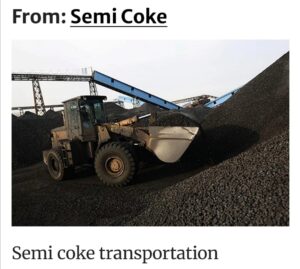SEMI COKE
Semi Coke
Properties
The main component is carbon, which can be divided into lump semi coke and powdery semi coke according to different particle sizes. The appearance is black gray to gray, with low ignition point and high specific resistance. Compared with coke, it has low density, high volatile content (7–20%), large porosity, and low mechanical strength. It has strong reactivity with carbon dioxide, steam, or oxygen. The properties of semi coke depend on the properties of raw coal and carbonization process. The raw materials for the production of semi coke are mostly low-rank coal with low ash, low sulfur, and low phosphorus, so it also has the characteristics of high fixed carbon, low ash, low sulfur, and low phosphorus. Semi coke has a large specific surface area. Some of its adsorption properties can be close to activated carbon or carbon molecular sieve.
Production Equipment And Process
The production equipment of semi coke is mainly retort furnace. According to different heating methods, retort furnace can be divided into external heating retort furnace, internal heating retort furnace, and internal and external mixed heating retort furnace. According to different furnace structures, it can be divided into vertical furnace, rotary kiln, horizontal furnace, and fluidized furnace.
Raw materials for the production of semi coke are mainly noncoking coal such as noncaking coal or weakly caking coal, and coal blending is not required. The production process can be divided into gas, solid, and gas-solid heat carrier carbonization process according to different heat carriers. Typical furnace types and processes include the following: Wood furnace process in the UK, Lurgi three-stage furnace process, Cobbs furnace process, Lurgi–ruhr (L-R) process in Germany, TOSCOAL process, low-rank coal conversion and upgrading (LFC) process and COED (coal oil energy development) process in the United States, internal heated vertical furnace process, external heated vertical furnace process, and rotary kiln process in China. The Wood furnace process is developed by the UK, and a continuous external heating vertical furnace is used, which is mainly used to produce town gas. Lurgi three-stage furnace process is designed and developed by Lurgi company in Germany. It adopts continuous internal heating retort for carbonization of lump coal and briquette with low adhesion. The L-R process was successfully developed by the Federal Republic of Germany. With the circulating hot semi coke powder as the heat carrier, the pulverized coal is mixed with the circulating hot semi coke powder in the retort and then quickly retorted into semi coke. Coopers furnace process is developed in Germany. It can be a reheating continuous vertical carbonization furnace heated by lean gas or rich gas. It is an external heating furnace type with alternating heating up and down. TOSCOAL process is proposed by the United States. The weakly cohesive coal is heated and retorted into semi coke by hot ceramic balls in the pyrolysis drum. LFC process is designed and developed by the United States. The coal is dried and retorted into semi coke by inert gas heat carrier in two steps in two rotary furnaces of drying and retorting. COED process was proposed by the United States in 1962. Pulverized coal is dry distilled into semi coke by hot gas in four continuous fluidized beds. The internal heating vertical furnace process is designed and developed by Sinosteel Anshan Research Institute of Thermal Energy Co., Ltd. The lump coal is in countercurrent contact with high-temperature gas from top to bottom, and finally retorted into semi coke through preheating section and retorting section. The external heating vertical furnace process is developed by China Anshan Coking & Refractory Design and Research Institute. A continuous vertical carbonization furnace is adopted. It is an external reheating furnace with reheating up and down. Lump coal is the raw material. The rotary kiln process is developed by Beijing Institute of Coal Chemistry, China. The coal is heated in the rotary kiln and finally retorted into semi coke.
Uses
Lump semi coke can be used as reducing agent in ferroalloys, calcium carbide, and other industries. It can also be used as gasification coke and civil smokeless fuel. Powdery semi coke can be used as blast furnace injection fuel, sintering fuel, and boiler fuel, as well as lean agent for coking and coal blending, and raw material of briquette/coke. Semi coke can be directly used as adsorption material. Low ash semi coke can be used to prepare activated carbon and carbon molecular sieve. The alkali-treated lignite semi coke can be used in the production of carbon disulfide (CS2) instead of charcoal.
Process can be used in the production of carbon disulfide (CS2) instead of charcoal.

Production Equipment and Process
Metals & mineral resource supply chain continuity:
Our competitive advantage is in risk management, financing, unique value sharing and long term strategic cooperation with the multiple upstream producer partners across Africa; this offers our customers from all over the world rare opportunity of guaranteed product availability throughout the year while at the same time optimizing scalability, flexibility and efficiency.
Metals and Mineral Resources
Copper
Iron Ore
Chrome
Manganese
Bauxite
Ilmenite
Calcium Carbonate
Refractory Metals
Rare Earth Metals


